Fashion brands don’t just wanna keep up with what’s new in fashion, but they’d also need to be aware of the latest social media trends.
Working on developing a marketing strategy that sells and also builds a loyal community is not easy. However, there are fashion brands like Mango that serve as an example.
Today we’re gonna peak at Mango’s marketing strategy and see how it can inspire and influence you to improve your own marketing game.
Mango's Marketing Strategy
1. What is Mango's marketing strategy on TikTok?
On TikTok, when it comes to creative concepts, Mango follows trends on TikToks, like the “week in outfits” trend or the “fashion haul” trend.
Mango uses a lot of playful videos on TikTok, posting mostly videos from influencers who follow the “get ready with me” trend.
Some of them record videos of themselves while getting ready for Mango events.
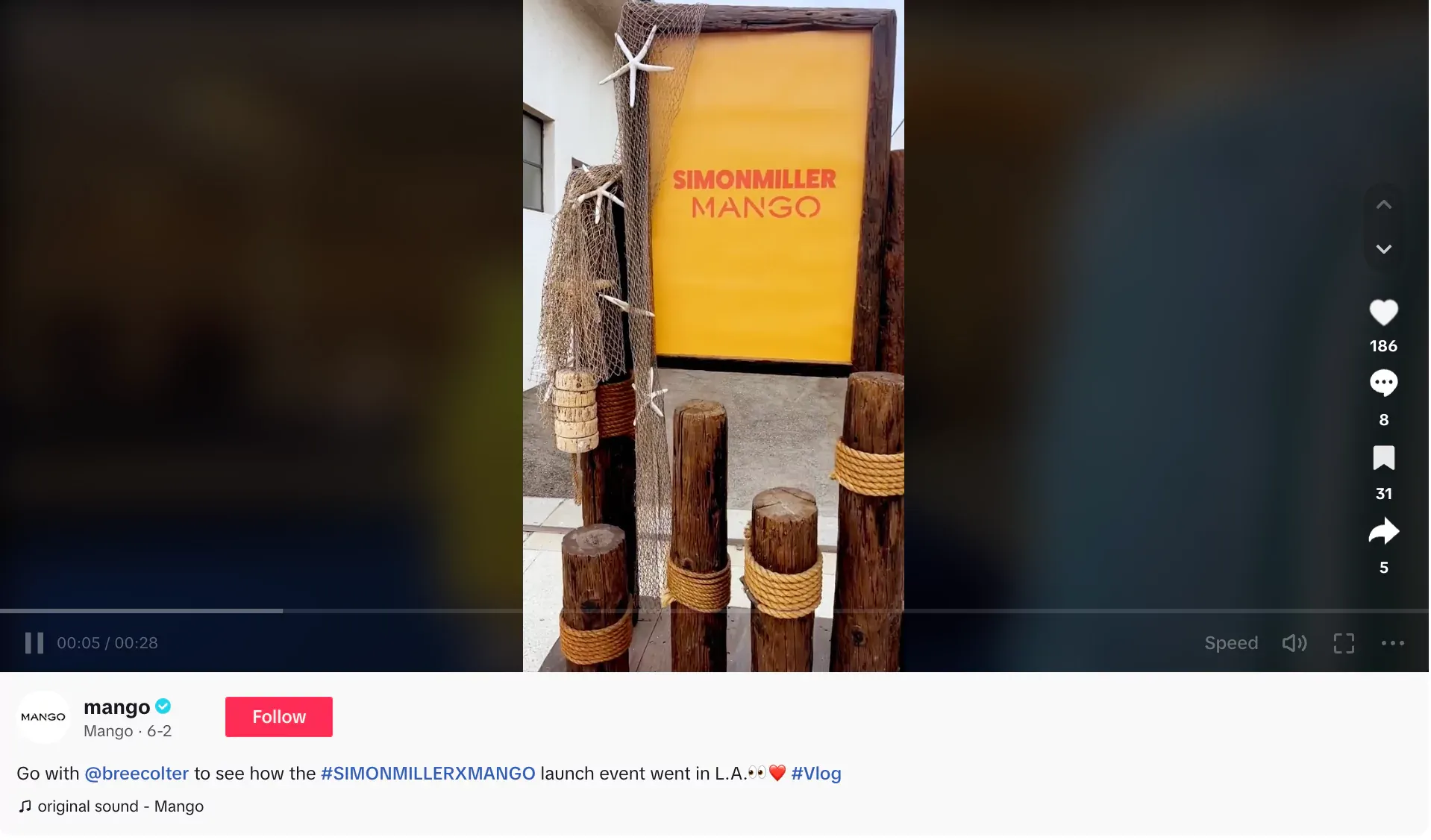
There are also couples who are influencers and they style matching outfits that look so cool and make them popular.
Besides the TikTok videos with kids, the ones with couples are also some of the most engaging ones.
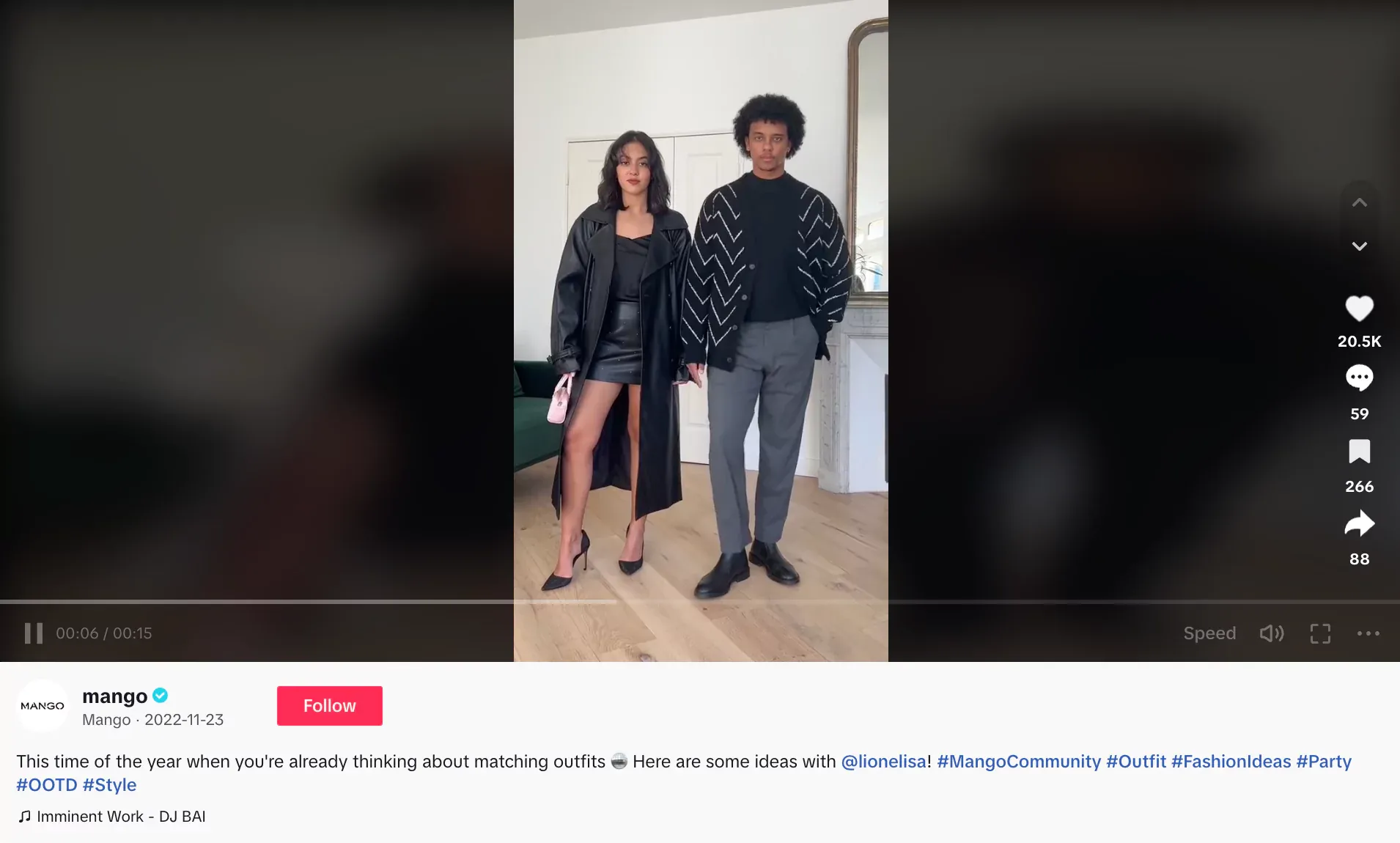
Another type of matching outfits videos are the ones with influencers and their kids. This type of content usually gathers the highest number of comments.
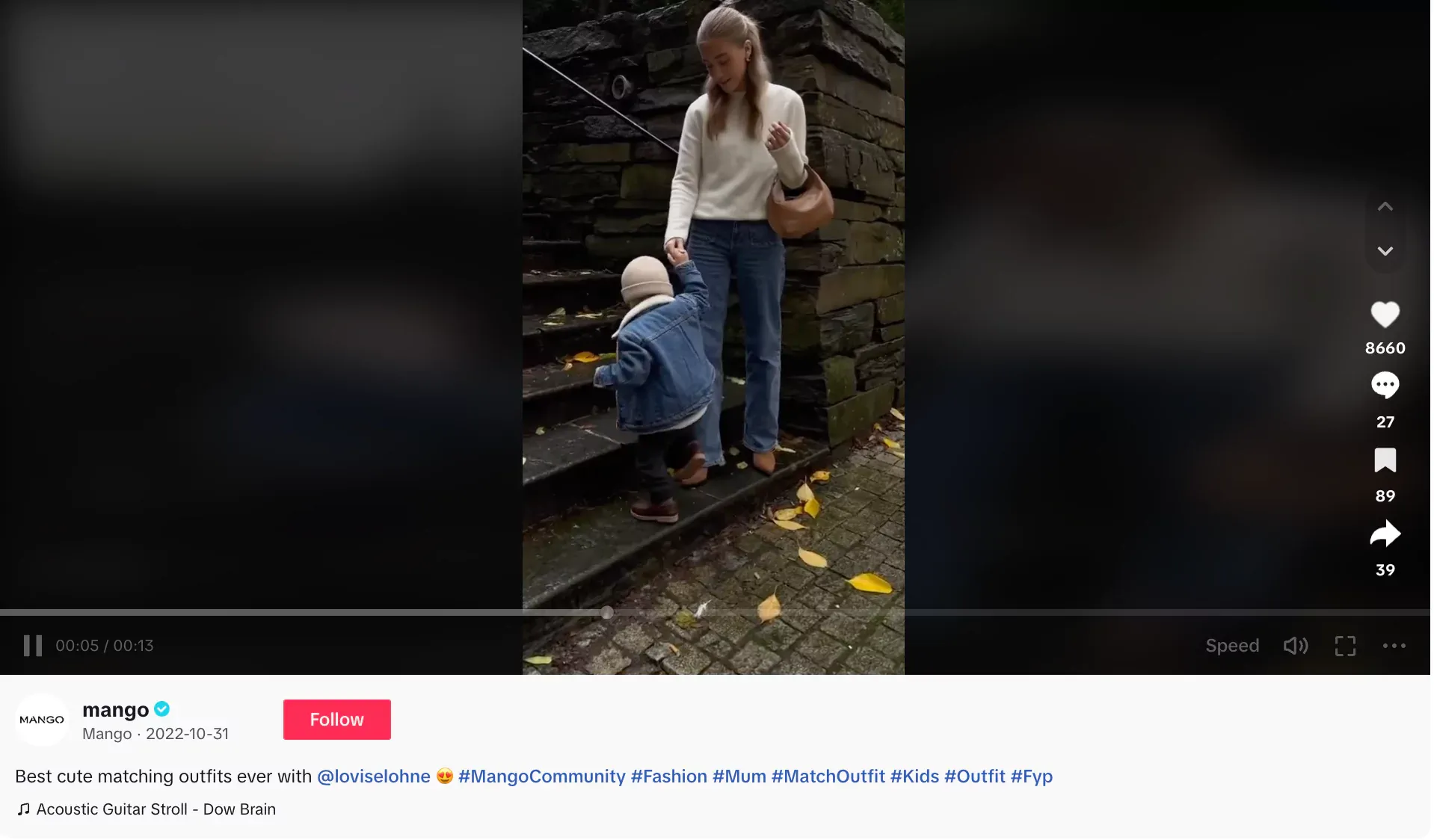
On Mango’s TikTok there are also videos about what outfits to wear depending on the occasion. And let me tell you that these are oh so inspiring.
What’s different from other retail brands that built a presence on TikTok is that Mango doesn’t use memes. This may come as a shock, but this doesn’t mean they don’t follow the trends.
To be honest, when scrolling through their TikTok posts, the content looks so fun that I don’t feel the need to see memes. I just don’t think they match in this context.
Another creative concept used in Mango’s TikToks relies on the trend “must-have items”. Influencers make up a list of the most popular clothing items to wear depending on the season and they showcase the styling.
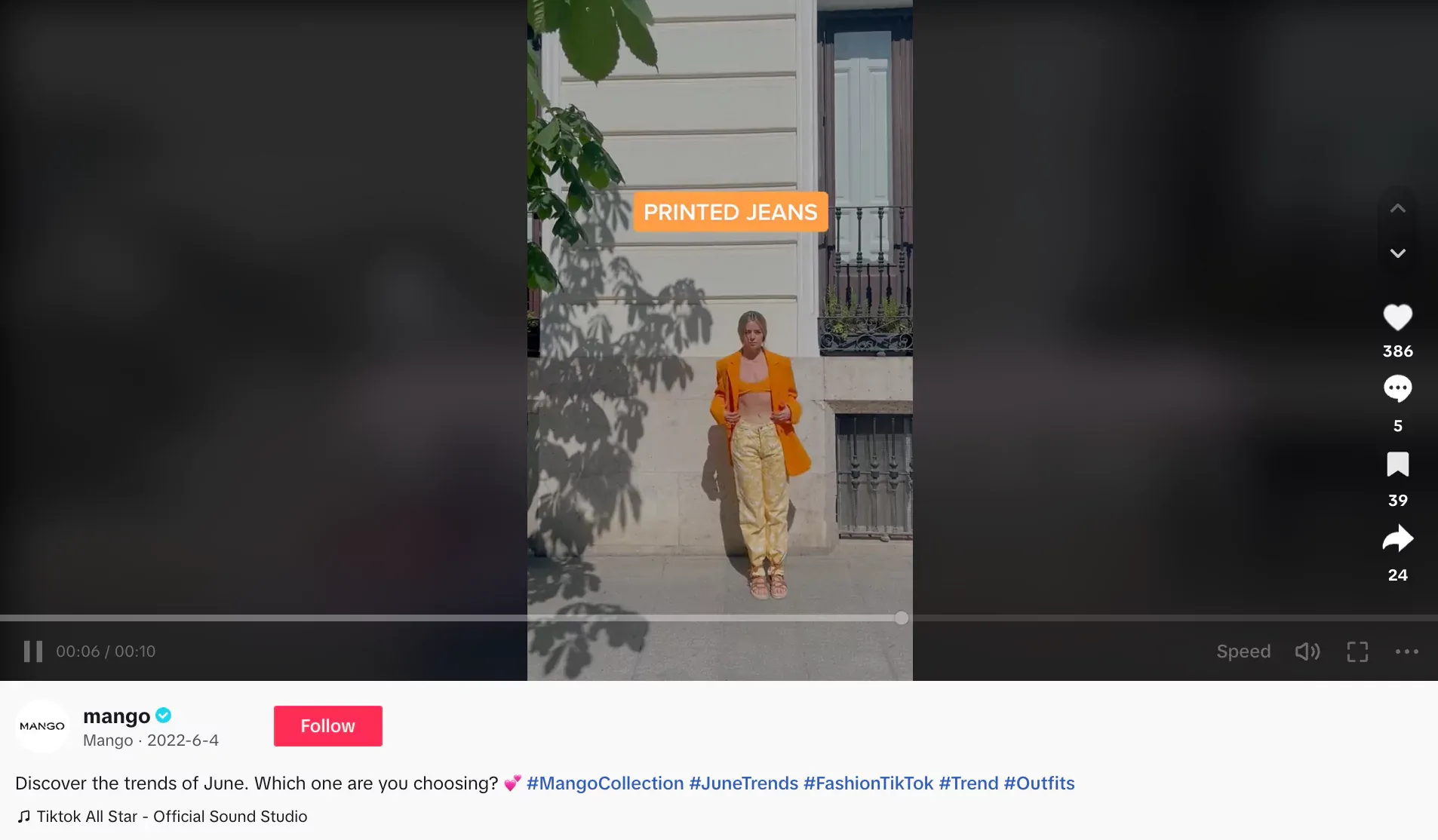
These videos are usually short, but they are so engaging, having a lot of likes.
2. What is Mango’s marketing strategy on Instagram?
One of the coolest creative concepts they use are videos with style coaches. They record videos of these style coaches that wear different items of clothing and the caption of the post includes the reference number of each piece of clothing.
How cool is that? If you like a certain pair of boots or a shirt and you’ve already got a styling idea, you can just go on their website and search it by that reference number and then get it right away.
This is what I call smart social media posts. Another great advantage of this type of posts is that, in case they don’t include the reference number for all items in the Reel, you can ask for them in the comments and the Mango team immediately responds.

They are making sure their community stays loyal, making them into happy customers. ‘Cause we all know that if it’s easy for you to find exactly what you’re looking for, you’re buying it.
Most of the time, carousels get more likes and comments than Reels do. The fact that the audience gets so many styling options in their Instagram carousels, makes them want to add more comments and ask about the colors available and how they can combine different pieces of clothing.
On Instagram, most carousels feature only 2 or 3 pictures. Most of the Reels posted here are “behind the scenes” videos from some professional photoshootings.
There also some creative Reels developed with the help of influencers, showcasing their outfits and sense of style.
Mango doesn’t use memes in their Instagram posts, probably because they wanna keep a clean and minimalist aesthetic, with all the colors combining perfectly.
Find out more about Mango's marketing strategy from out podcast episoade "The life of a Social Media Manager" with Estela Alcaide, Online Communication Manager @Mango.
3. How to do a competitive brand analysis with Socialinsider
Checking your brand’s performance is mandatory when your main goal is to grow on all levels.
Developing a social media audit by using a specialised tool or checking your competitors’ performance to see where you’re standing in your niche it’s really important.
To see the overall performance of a brand like Mango is easy-peasy with a social media analytics & benchmarking tool like Socialinsider. Let me show you how you can do it for your own brand.
I developed two different brands in the dashboard, one named Mango and one named H&M, including these two rival brands’ social media platforms like Instagram, Facebook and TikTok.
By looking at these two fashion brands’ performance for the last 6 months, we discovered a few useful insights based on the competitive analysis developed with Socialinsider that can help to adjust their marketing strategy.
The number of fans for Zara shows a big decrease compared to the one of Mango’s. However, Mango indicates a lower engagement rate than the one of its competitor, Zara, for the last six months.

The great part about this competitive analysis with Socialinsider is that you can clearly see the distinction between the two fashion brands, depending on the social media metrics you choose to evaluate and compare.
When it comes to average engagement, Zara has a higher engagement rate per post on TikTok compared to Mango. When it comes to Instagram, things seem to change and both fashion brands have pretty much the same engagement rate per post.
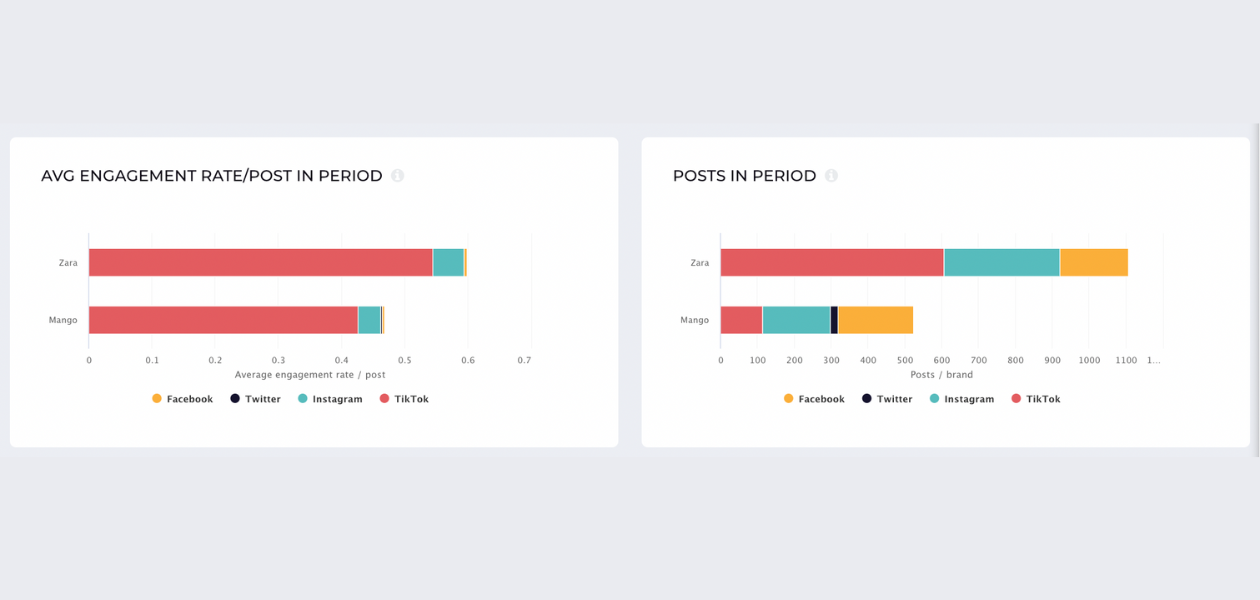
When comparing posts, Mango and Zara have about the same number of posts on Facebook.
Using a competitive analytics tool like Socialinsider helps you compare the most important metrics to establish peak performance. The insights offered and the ways you can get inspired by your competitors help you adjust your marketing strategy to get better results.
This way, you will be able to come up with more creative content, accustomed to your audience’s needs, to help you reach your brand’s goals.
With Socialinsider, you can gather a lot more value than you imagine by using its Brands and Benchmarking feature, putting together new bricks for a solid marketing strategy.
4. Key takeaways for Mango’s marketing strategy on social media
The strategy behind Mango’s social media relies on a lot of influencer marketing on TikTok and products pictures on Instagram.
Even if the aesthetics is pretty much the same on these two social media platforms, on Instagram Mango posts more carousels while on TikTok they only post videos.
The user experience is incredibly important
On both social media platforms, Mango focuses on responding very quickly to their audience’s inquiries. They know how to keep their clients and future clients satisfied, offering them a solution every time they find it hard to find a particular item.
Mango’s marketing strategy seems to be the same on both Instagram and TikTok. They hire models of different body sizes to showcase the wide variety and versatility of their products.
Quality over quantity
The posting frequency on Instagram differs. There are days when they don’t post anything and then days when they have 3 posts. This means it all depends on their current marketing campaign and the items they want to commercialize.
There are certain products that become viral based on the styling combination and the greatness of the concept behind the post. People praise what they see and they go to Mango’s website to add to cart.
Mainly, Mango’s marketing strategy relies on posting quality content that really makes a difference in the world of fashion, relieving unique concepts and styling ideas.
Influencer marketing rocks
On TikTok, Mango posts once every day. Most of their TikTok videos are influencers’ collabs. It seems this is their go-to approach that offers great results for them.
The same influencers that develop content for Mango’s TikTok also make posts for their Instagram.
The great thing about Mango’s influencers’ collabs is that they allow the influencers to bring their own creative contribution, building content that suits their personalities.
On both TikTok and Instagram, Julia Hobbs posts all sorts of “get ready with me” videos that inspire women how to combine their favorite clothing items. She also talks about the latest fashion trends, like the “no pants” trend.
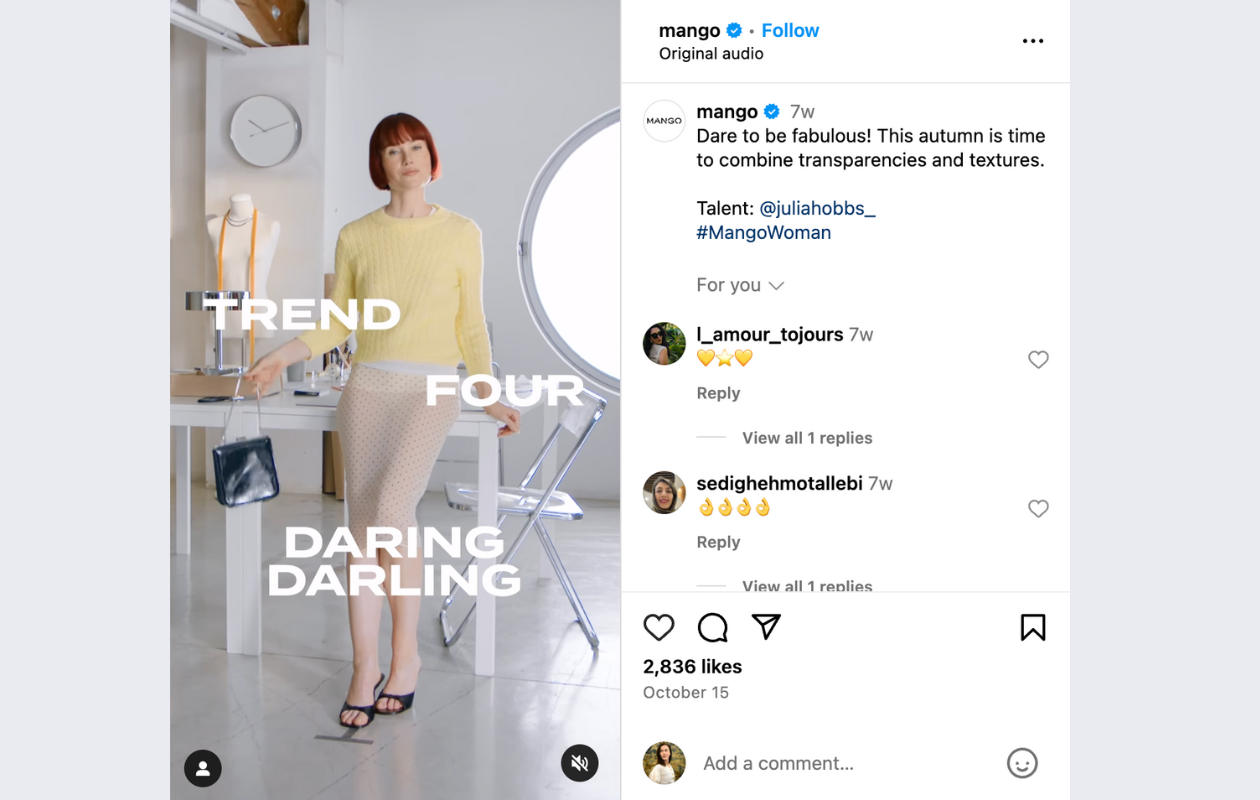
Another style coach, Monica Ainley de la Villardiere makes a lot of videos with their favorite items from Mango that she wore during important events. She showcases simple styling options that can be used by anyone.
Her videos are also a bit longer than the rest (almost 2 minutes) because they are full of useful explanations.
Another influencer, Olesia Les, posts videos of her reworking old Mango items, offering new life to clothes by merging them into something new.
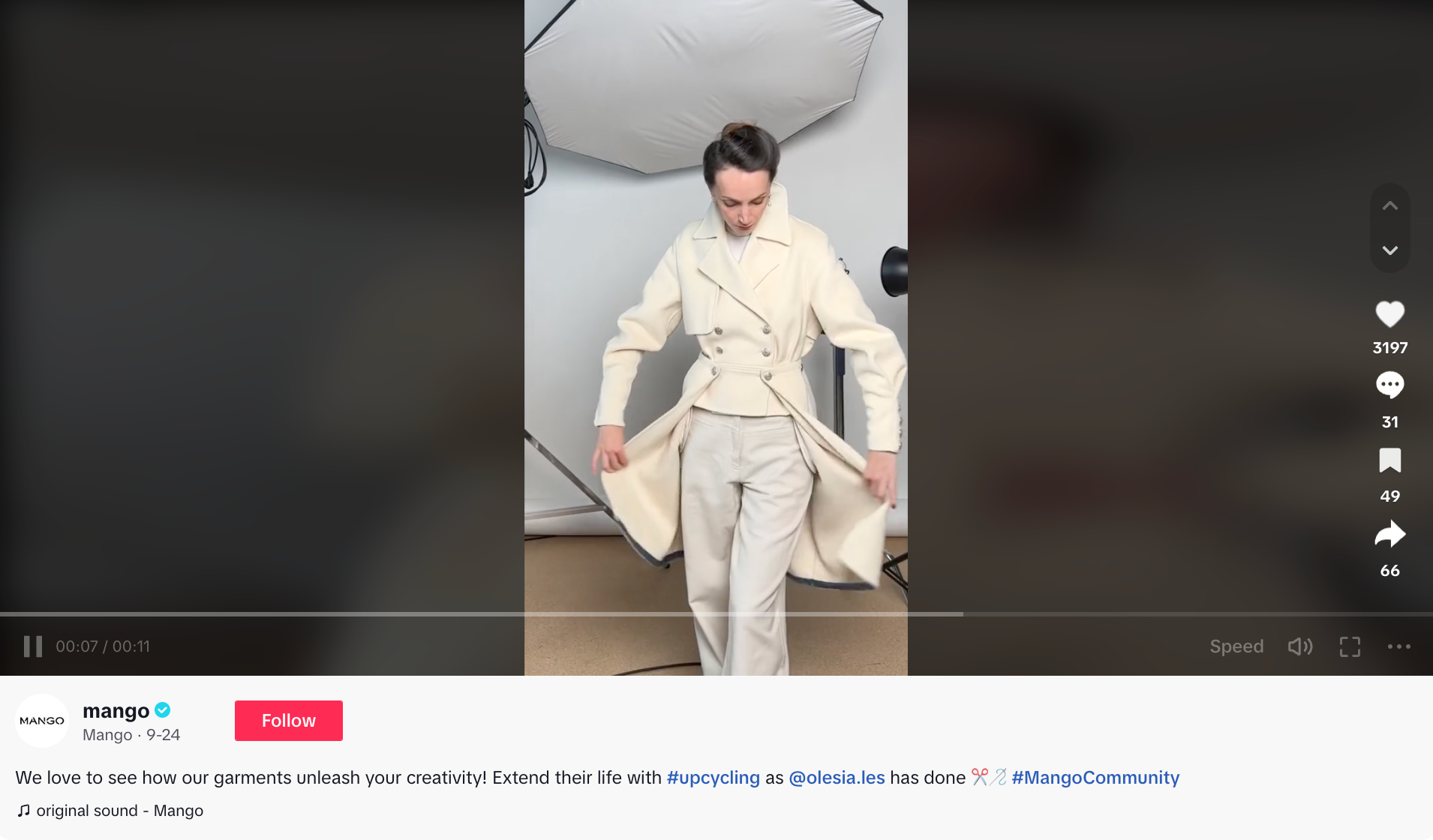
On TikTok, there are other influencers that make fashion haul’s videos whenever they get new items from Mango. Those videos are longer than the rest, showing how the influencer mixes and matches the clothing items.
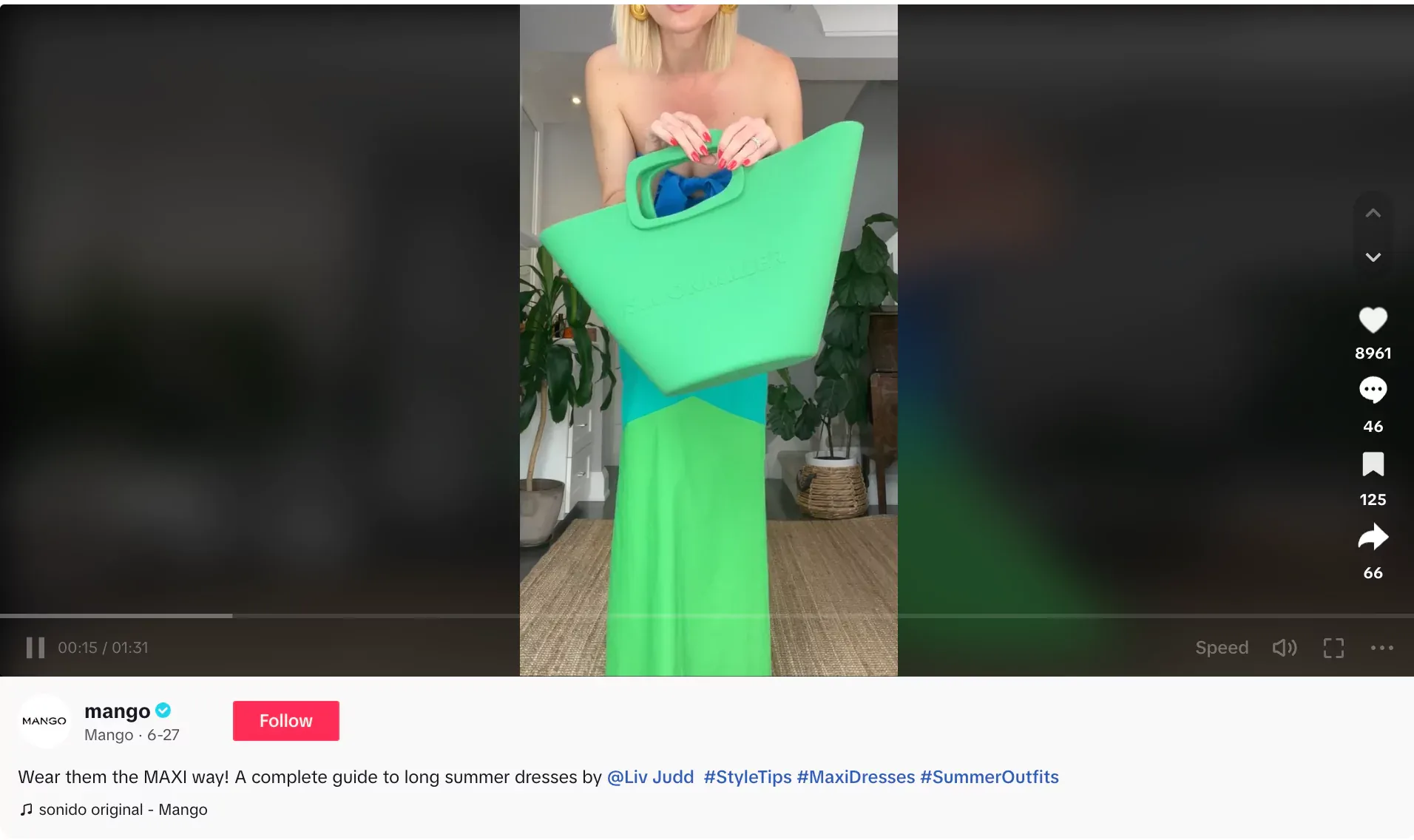
Fashion for all
Another great advantage when it comes to Mango’s posts is that they don’t limit to posting only women’s fashion. They have a lot of clothing items for men and kids too.
Mango also works with influencers that have kids, putting together matching outfits. Those posts don’t only look cute, but they are also highly engaging.
The TikTok videos with kids get more comments.
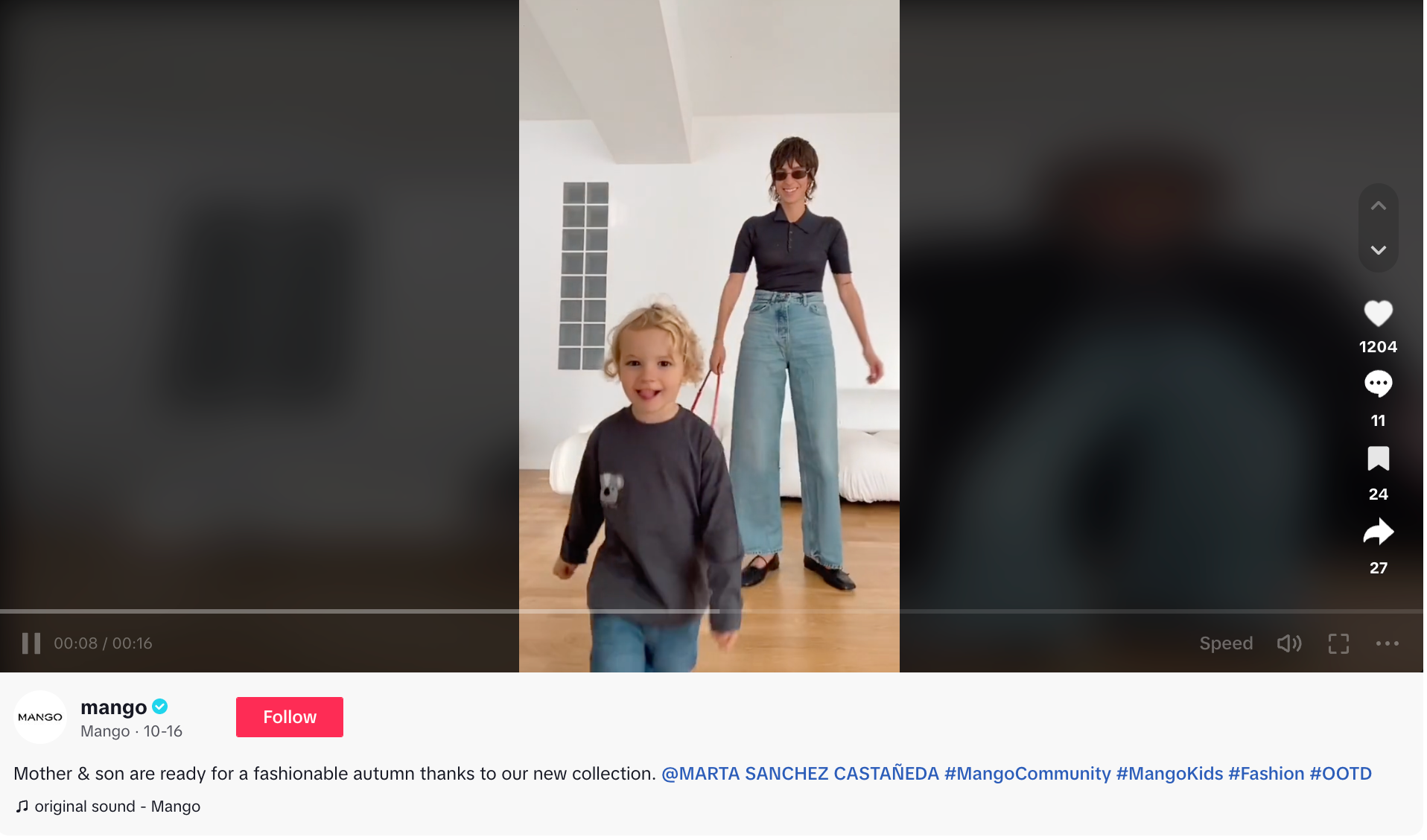
Mango has also launched a home collection, including a lot of versatile products and timeless home items, like cushions, covers and decorations that can elevate the entire home design and empower the feeling of home.
Live Shopping Sessions
The influencer they collaborate with the most is Monica Ainley de la Villardiere, styling coach and live shopping assistant.
Periodically, Mango organizes with Monica some live shopping sessions where she offers customers advice about Mango items, how to style them, where to wear certain products and on which occasions.
The live shopping sessions are announced through Reels on Instagram, but they take place on Mango’s website and on their app. These live sessions represent a great opportunity for clients to get free advice from a styling specialist.

Final thoughts
From a recognizable brand, a platform-oriented and humanized content strategy, diverse and trendy social media campaigns, to an intelligent approach to influencer marketing, Mango seems to have found what it takes to be successful online.
An active presence and a high engagement rate on social channels are essential for a brand's success, mainly if one's audience is particularly formed of millennials and Gen Zs, as is the case of Mango.
Mango's social media strategies can be adapted to every type of business and incorporated into any existing marketing strategy.
![[Brand Analysis] Mango’s Marketing Strategy - Get Inspired With These Tips & Tricks](/blog/content/images/size/w2000/2023/12/New-size-blog-cover-templates---2023-12-05T115200.904.png)







![[Brand Analysis] Innocent Drinks' Marketing Strategy: How Authenticity Defines Their Social Success](/blog/content/images/size/w1000/2022/12/innocent-drinks-marketing-strategy.png)

